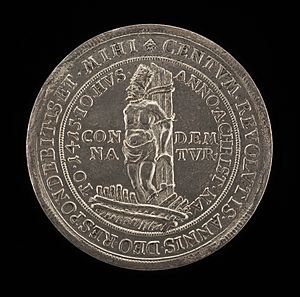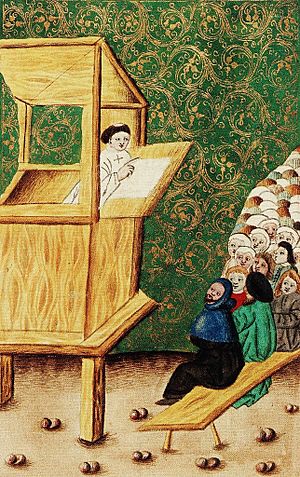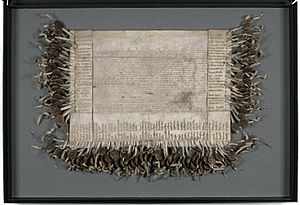Jan Hus facts for kids
Quick facts for kids
Jan Hus
|
|
|---|---|
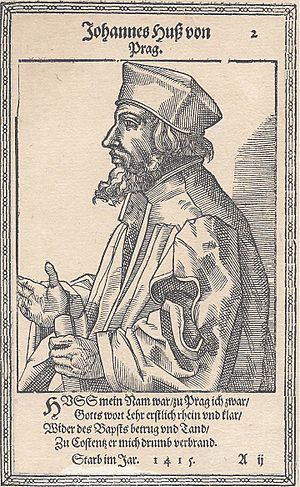
Woodcut of Jan Hus, c. 1587
|
|
| Born | c. 1369 |
| Died | 6 July 1415 (aged 44–45) |
| Other names | John Hus, John Huss |
| Alma mater | University of Prague |
| Era | Renaissance philosophy |
| Region | Western philosophy |
| School | Hussite |
|
Main interests
|
Theology |
|
Influences
|
|
|
Influenced
|
|
Jan Hus (born around 1370 – died July 6, 1415) was a Czech theologian and philosopher. He became an important Church reformer. His ideas inspired a movement called Hussitism, which was a major step towards Protestantism. Hus is seen as a key figure in the Bohemian Reformation.
Some people even consider Hus to be the first Church reformer. His teachings greatly influenced the Bohemian religious denomination. More than a century later, his ideas also impacted Martin Luther. Hus was a master, dean, and rector at the Charles University in Prague from 1409 to 1410.
Jan Hus was born in Husinec, Bohemia, to a poor family. To escape poverty, he trained to become a priest. He moved to Prague at a young age. There, he supported himself by singing and working in churches. He was known for his good behavior and his strong commitment to his studies. After becoming a priest, Hus began to preach in Prague. He disagreed with many practices of the Catholic Church in Bohemia. These included their views on church organization, selling church positions, and the Eucharist.
When Alexander V became pope, he was convinced to side with the Bohemian Church leaders against Hus. Alexander V issued a Papal bull that removed Hus from the Church. However, this order was not fully carried out, and Hus continued to preach. Hus then spoke out against Alexander V's successor, Antipope John XXIII. He criticized John XXIII for selling indulgences, which were pardons for sins. Because of this, Hus was officially removed from the Church and spent two years living away from Prague.
Hus was later asked to attend the Council of Constance to share his views. He was promised safe conduct to ensure his safety. However, when he arrived, he was immediately arrested and put in prison. He was brought before the council and asked to change his views. He famously replied, "I would not for a chapel of gold retreat from the truth!" He refused to change his mind and was sent back to prison. On July 6, 1415, he was burned at the stake for heresy. This meant he was accused of going against the teachings of the Catholic Church. People heard him singing Psalms as he was dying. Hus predicted that God would raise others who would continue his call for reform. This was later seen as a prophecy about Martin Luther.
After Hus was executed, his followers, known as Hussites, refused to accept another Catholic ruler. They fought and won against five papal crusades between 1420 and 1431. These conflicts became known as the Hussite Wars. Most people in Bohemia and Moravia remained Hussite until the 1620s. After a Protestant defeat in the Battle of White Mountain, the region came under Habsburg rule. This led to a strong effort to convert people back to Catholicism.
Contents
Early Life and Education
Hus was born in Husinec, a village in southern Bohemia. His parents were peasants. He took his name from his village, which was a common custom. The name "Hus" means "goose" in Czech. Later, he was called a "Bohemian goose."
Around age 10, Hus was sent to a monastery. He impressed his teachers with his studies. They suggested he move to Prague, one of Bohemia's largest cities. In Prague, Hus found work to support himself. He also gained access to the Prague Library.
Three years later, he was accepted into the University of Prague. He studied very hard. In 1393, Hus earned his Bachelor of Arts degree. He then earned his master's degree in 1396. Many professors at the university held strong views against the pope. This likely influenced Hus's later ideas.
Becoming a Preacher
Hus began teaching at the University of Prague in 1398. In 1399, he publicly supported the ideas of John Wycliffe. By 1401, his students and teachers made him dean of the philosophy department. A year later, he became a rector of the University of Prague. In 1402, he was appointed a preacher at the Bethlehem Chapel.
Hus strongly supported the Czech people and their language. He was also influenced by Wycliffe's writings. Even though church leaders banned many of Wycliffe's works in 1403, Hus translated one of them, Trialogus, into Czech. He helped share it with others.
From his pulpit, Hus spoke out against the moral failures of clergy, bishops, and even the pope. Archbishop Zbyněk Zajíc at first allowed this. He even appointed Hus as a preacher at a church meeting. However, in 1405, Pope Innocent VII told the Archbishop to stop Wycliffe's teachings. The Archbishop then issued a decree against Wycliffe. He also forbade any more attacks on the clergy.
In 1406, two Czech students brought a document from the University of Oxford to Prague. It praised Wycliffe. Hus proudly read this document from his pulpit. Then, in 1408, Pope Gregory XII warned Archbishop Zajic about Wycliffe's heresies. The king and university then ordered all of Wycliffe's writings to be given to the church for review. Hus obeyed, saying he condemned any errors in those writings.
Challenging Church Practices
In 1408, the Charles University in Prague was divided by the Western Schism. This was a time when two different men claimed to be the pope. One was Gregory XII in Rome, and the other was Benedict XIII in Avignon. King Wenceslaus IV of Bohemia wanted to be crowned Holy Roman Emperor. He felt Gregory XII might interfere with his plans. So, he ordered the clergy in Bohemia to stay neutral in the schism. He expected the university to do the same. Archbishop Zajíc remained loyal to Gregory. At the university, only the Czech "nation" (one of the four main groups of students), led by Hus, promised to be neutral.
The Kutná Hora Decree
In January 1409, King Wenceslaus called representatives from the university to the city of Kutná Hora. He wanted them to declare their loyalty. The Czech group agreed, but the other three groups refused. The king then declared that the Czech group would have three votes in university matters. The "German nation" (made up of Bavarian, Saxon, and Polish students) would have only one vote.
Because of this change, the German dean and rector were removed by May 1409. They were replaced by Czechs. Many German students and masters left Prague. It's estimated that over a thousand left. These emigrants also spread rumors about heresy in Bohemia.
New Popes and Excommunication
In 1409, the Council of Pisa tried to end the schism by electing Alexander V as pope. But Gregory and Benedict did not give up their claims. Hus, his followers, and King Wenceslaus IV supported Alexander V. Under pressure from the king, Archbishop Zajíc also supported Alexander V. Zajíc then accused Wycliffe's followers in Prague of causing "church problems" to Alexander V.
On December 20, 1409, Alexander V issued a papal bull. This gave the Archbishop power to act against Wycliffism in Prague. All copies of Wycliffe's writings were to be given up, and his teachings were to be rejected. Free preaching was also to stop. After this order was made public in 1410, Hus appealed to Alexander V, but it was no use. Wycliffe's books were burned. Hus and his supporters were removed from the Church by Alexander V.
Speaking Out Against Indulgences
Alexander V died in 1410. He was replaced by John XXIII. In 1411, John XXIII announced a crusade against King Ladislaus of Naples. Ladislaus was protecting the rival Pope Gregory XII. This crusade was also preached in Prague. John XXIII also allowed the selling of indulgences to raise money for the war. Priests urged people to give offerings. This selling of indulgences showed that the Church needed reform.
Archbishop Zajíc died in 1411. After his death, the religious movement in Bohemia changed. The arguments about indulgences became very important. Hus spoke out against indulgences. He said that no pope or bishop had the right to use force in the name of the Church. He believed they should pray for their enemies. He also said that people get forgiveness for sins through true regret, not money.
A few days later, some of Hus's followers burned the Papal bulls. They said Hus should be obeyed more than the Church. They saw the Church as corrupt. In response, three poor men who openly called the indulgences a fraud were executed. They are now seen as the first martyrs of the Hussite Church. The university faculty condemned Hus's ideas. The king forbade teaching these ideas, but Hus and the university did not obey. They asked for proof that the ideas were against the Bible.
Attempts at Peace
King Wenceslaus IV tried to bring the two sides together. In 1412, he called a meeting of his kingdom's leaders. They suggested holding a church meeting at Český Brod. However, the meeting was held in Prague to keep Hus from attending. Ideas were proposed to bring peace to the Church. Hus said that Bohemia should have the same freedom in church matters as other countries. He believed that church approvals or condemnations should only happen with the state's permission. This was an idea from Wycliffe.
Hus wrote at the time, "Even if I should stand before the stake which has been prepared for me, I would never accept the recommendation of the theological faculty." The meeting did not solve anything. The king then ordered a group to continue working on peace. The university's scholars demanded that Hus and his followers agree with their view of the Church. This view said the pope was the head of the Church and the Cardinals were its body. Hus strongly disagreed.
Hus's followers tried hard to find a solution. They added to the rule that the Roman Church must be obeyed: "so far as every pious Christian is bound." This small addition caused two of Hus's opponents to protest and leave. The king then sent them into exile.
Hus Leaves Prague
By this time, Hus's ideas were widely accepted in Bohemia. There was much anger against the Church leaders. The attacks on Hus by the pope and archbishop caused riots in Bohemia. King Wenceslaus IV and his government supported Hus. Hus's followers grew stronger every day. Hus continued to preach in the Bethlehem Chapel. The churches in Prague were put under a ban, and a church interdict was declared against the city. To protect Prague, Hus left and went to the countryside. There, he continued to preach and write.
Before leaving Prague, Hus made a big decision. On October 18, 1412, he appealed directly to Jesus Christ as the highest judge. By doing this, he bypassed the laws and structures of the medieval Church. For the Bohemian Reformation, this step was as important as Martin Luther's 95 theses in 1517.
After Hus left Prague, he realized the difference between university studies and the lives of uneducated country priests and ordinary people. So, he began to write many texts in Czech. These included basics of the Christian faith and sermons. They were mainly for priests who did not know Latin well.
Hus's Writings
One of Hus's most important writings was De Ecclesia (On the Church), written in 1413. Its first ten chapters are a summary of Wycliffe's work with the same title. The later chapters are from another of Wycliffe's works about the pope's power. Wycliffe had written his book to argue against the idea that the Church was mainly the clergy. Hus now made the same point. He wrote his work at the castle of one of his protectors and sent it to Prague. It was read publicly in the Bethlehem Chapel.
After Hus's strongest opponents left Prague, his supporters took over. Hus wrote and preached near Kozí Hrádek. Czech Wycliffism spread to Poland, Hungary, Croatia, and Austria. But in January 1413, a general council in Rome condemned Wycliffe's writings and ordered them burned.
Journey to Constance
King Wenceslaus's brother, Sigismund of Hungary, was the "King of the Romans" and heir to the Bohemian crown. He wanted to end the religious disagreements in the Church. To stop the papal schism and reform the Church, he arranged a general council. It was to meet on November 1, 1414, in Konstanz (Constance). The Council of Constance (1414–1418) became the 16th ecumenical council recognized by the Catholic Church. Hus agreed to go to Constance, as Sigismund promised him safe conduct.
Arrest and Trial
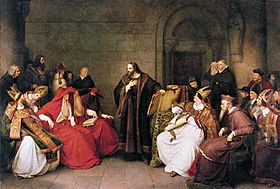
Hus made his will before leaving, perhaps knowing his fate. He started his journey on October 11, 1414, and arrived in Constance on November 3. The next day, notices on church doors announced that Michal z Německého Brodu would speak against Hus.
At first, Hus was free under Sigismund's safe conduct. He lived at a widow's house. But he continued to celebrate Mass and preach, which went against Church rules. After a few weeks, on November 28, 1414, his opponents managed to imprison him. They spread a rumor that he planned to flee. He was first taken to a canon's house, then to the prison of the Dominican monastery on December 6. Sigismund was very angry because he had guaranteed Hus's safety. But the church leaders convinced him that he didn't have to keep promises to a heretic.
On December 4, 1414, John XXIII assigned three bishops to investigate Hus. Witnesses against Hus were heard, but Hus was not allowed a lawyer. His situation worsened after John XXIII left Constance to avoid giving up his power. Hus, who had been John XXIII's prisoner, was then given to the bishop of Constance. He was moved to Gottlieben castle on the Rhine. He stayed there for 73 days, chained day and night, poorly fed, and sick.
His Final Stand
On June 5, 1415, Hus had his first trial. He was moved to a Franciscan monastery for his last weeks. Parts of his writings were read, and witnesses spoke. He refused to fully give in, but said he would change his views if his errors could be proven from the Bible. Hus admitted he admired Wycliffe. He said he wished his soul could go to the same place as Wycliffe's. However, he denied defending Wycliffe's ideas about The Lord's Supper or the forty-five articles. He had only opposed their quick condemnation. King Sigismund told him to trust the council's mercy, as he did not want to protect a heretic.
At the last trial on June 8, 1415, thirty-nine sentences were read to him. These were taken from his books. The council explained to Sigismund how some of these ideas could threaten worldly power. Hus again said he would submit if he could be shown his errors. This was seen as a complete surrender. He was asked to confess:
- That he had made mistakes in his ideas.
- That he would give them up for the future.
- That he took back his words.
- That he declared the opposite of these sentences.
He asked not to take back ideas he had never taught. He also refused to change other ideas that the council thought were wrong. He said it would go against his conscience. These words were not well received. After the trial on June 8, several more attempts were made to get him to change his mind, but he refused.
His Execution
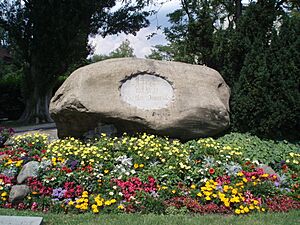
Jan Hus was condemned on July 6, 1415. This happened during a meeting of the council in the cathedral. After the High Mass, Hus was led into the church. The Bishop of Lodi gave a speech about the duty to stop heresy. Then, various ideas of Hus and Wycliffe were read, along with a report of Hus's trial.
An Italian church leader then announced the condemnation of Hus and his writings. Hus protested, saying he only wanted to be convinced by the Bible. He knelt down and quietly asked God to forgive all his enemies. Then came his degradation. He was dressed in priestly clothes and again asked to change his mind, but he refused. With curses, Hus's priestly items were taken from him. His priestly tonsure (shaved head) was destroyed. The Church's sentence was announced, taking away all his rights. He was then handed over to the government authorities. A tall paper hat was put on his head. It had the word "Haeresiarcha" (leader of a heretical movement) written on it. Hus was then led to the stake by a strong guard of armed men.
Before his execution, Hus is said to have declared, "You may kill a weak goose [Hus is Czech for "goose"], but more powerful birds, eagles and falcons, will come after me." Later, Luther changed this statement. He reported that Hus had said they might have roasted a goose, but in a hundred years, a swan would sing whom they would have to listen to. This was seen as a prophecy about Luther himself.
At the place of execution, he knelt, spread his hands, and prayed aloud. At the very last moment, the imperial marshal asked Hus to change his mind and save his life. But Hus refused.
What Happened After Hus Died?
The Bohemian Protest
News of Hus's death caused great anger among the local nobles and scholars. On September 2, 1415, a document called the Bohemian Protest was signed. It had wax seals from 100 important people from Bohemia and Moravia. They protested Jan Hus's burning. The document stated that "Master John Hus was a good, just and catholic man." It also said he "consistently detested all error and heresies." Anyone who believed heresy was rising in Bohemia or Moravia was called "the worst of traitors."
The Hussite Wars
The people of Bohemia were horrified by Hus's execution. They moved even further away from the Pope's teachings. Rome then declared a crusade against them on March 1, 1420. Pope Martin V issued a Papal bull allowing the execution of all supporters of Hus and Wycliffe. King Wenceslaus IV died in August 1419. His brother, Sigismund of Hungary, could not control Bohemia because of the Hussite revolt.
Most of the Czech people in Bohemia were Hussites. Under the leadership of Jan Žižka (c. 1360 – 1424) and later Prokop the Great (c. 1380 – 1434), the Hussites defeated the first crusade and three more that followed (1419–1434). The fighting ended after a compromise between the Utraquist Hussites and the Catholic Council of Basel in 1436. This led to the Basel Compacts. The Catholic Church officially allowed Bohemia to practice its own version of Christianity (Hussitism). A century later, about ninety percent of the people in the Czech Crown lands still followed Hussite teachings.


Hus's Ideas and Legacy
His Teachings
Hus left behind many writings about reform. He translated Wycliffe's Trialogus. He was very familiar with Wycliffe's works on the body of Jesus, the Church, and the pope's power. There is strong evidence that Wycliffe's idea of the Lord's Supper (that Christ is present with the bread and wine, not that they become his body and blood) had spread to Prague by 1399. Hus preached and taught this idea. This teaching was eagerly adopted by the Taborites.
According to Hus's book, the Church is not just the clergy. The Church is the entire group of people chosen for salvation. Christ, not the pope, is its head. It is not a rule of faith that one must obey the pope to be saved. Being a member of the Church or holding church offices does not guarantee that a person is part of the true Church.
Hus wanted to remove bad practices from the Church. The beginnings of the Reformation are clear in Hus's and Wycliffe's writings. Hus wrote about the struggles of ordinary Christians in Bohemia: "One pays for confession, for Mass, for the sacrament, for indulgences... The very last penny which an old woman has hidden in her bundle for fear of thieves or robbery will not be saved. The villainous priest will grab it." After Hus's death, his followers, the Hussites, split into groups like the Utraquists and Taborites.

Nearly six centuries later, in 1999, Pope John Paul II expressed "deep regret for the cruel death inflicted" on Hus. He added "deep sorrow" for Hus's death and praised his "moral courage."
Impact on the Czech Language
Jan Hus's works included changes to medieval Czech orthography (the way words are spelled). He introduced the "hook" (háček) mark. This mark helped create letters like ⟨č⟩, ⟨ě⟩, ⟨š⟩, ⟨ř⟩, and ⟨ž⟩. These new letters replaced older ways of writing sounds, like ⟨cz⟩ or ⟨sch⟩. He also used the acute accent to mark long vowels, like ⟨á⟩ and ⟨é⟩. This helped represent each sound with a single symbol. The book Orthographia Bohemica (1406) is thought to have been written by Hus.
Lasting Influence
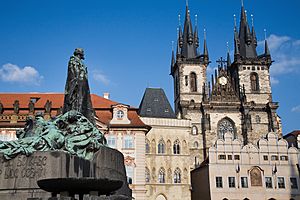
A century after the Hussite Wars began, as many as 90% of people in the Czech lands were Hussites. Bohemia was home to one of the most important movements before the Reformation. Even today, there are still Protestant followers, though they are no longer the majority. This is due to historical reasons like persecution by the Catholic Habsburgs and restrictions during Communist rule.
Jan Hus was a key contributor to Protestantism. His teachings strongly influenced European states and Martin Luther. The Hussite Wars led to the Basel Compacts. These allowed for a reformed Church in Bohemia, almost a century before similar changes happened in the Lutheran Reformation. The Unitas Fratrum (or Moravian Church) is the modern home of Hus's followers. Hus's many writings earned him an important place in Czech literary history.
In 1883, the Czech composer Antonin Dvorak composed his Hussite Overture. It was based on melodies used by Hussite soldiers.
Today, the Jan Hus Memorial is in Prague's Old Town Square. There are also many smaller memorials in other Czech towns. In New York City, a church in Brooklyn and a church and theater in Manhattan are named after Hus.
Some Eastern Orthodox Christians believe Hus's theology was closer to Eastern Orthodox Christianity. Jan Hus is considered a martyr saint in some parts of the Orthodox Church. The Czechoslovak Hussite Church claims to trace its origin to Hus. It has a mix of Eastern Orthodox and Protestant elements.
In a 2015 survey by Czech Radio, Hus was voted the greatest hero of the Czech nation.
Famous People Connected to Jan Hus
- Jerome of Prague (died 1416): Hus's friend and follower who was also burned at Konstanz.
- Jan Žižka z Trocnova a Kalicha (c. 1360–1424): A Czech general and Hussite leader.
- John Amos Comenius (1592–1670): A pastor, teacher, philosopher, and writer. He was the last bishop of the Unitas Fratrum before it was renewed. He was an early supporter of education for everyone and in one's native language.
Images for kids
-
Alphonse Mucha: Master Jan Hus Preaching at the Bethlehem Chapel: Truth prevails, 1916; part of the 20-painting work, The Slav Epic
Works
- Iohannes Hus. Postilla adumbrata, ed. G. Silagi (Corpus Christianorum. Continuatio Mediaevalis 261), Turnhout: Brepols Publishers (ISBN: 978-2-503-55275-0)
- De Ecclesia. The Church, Jan Hus; David S. Schaff, translator, New York, Charles Scribner's Sons, 1915.
- Letters of John Huss Written During His Exile and Imprisonment, Jan Hus; Campbell Mackenzie, translator, Edinburgh, William Whyte & co., 1846
- The letters of John Hus, Jan Hus; Herbert B. Workman; R. Martin Pope, London, Hodder and Stoughton, 1904.
- The Letters of John Hus, Jan Hus; Matthew Spinka, translator.
- The Letters of John Hus
See also
 In Spanish: Jan Hus para niños
In Spanish: Jan Hus para niños
- Orthographia bohemica, a treatise thought to have been written by Jan Hus
- Jan Hus Presbyterian Church, a New York City parish of the Presbyterian Church (USA) and named after Jan Hus


